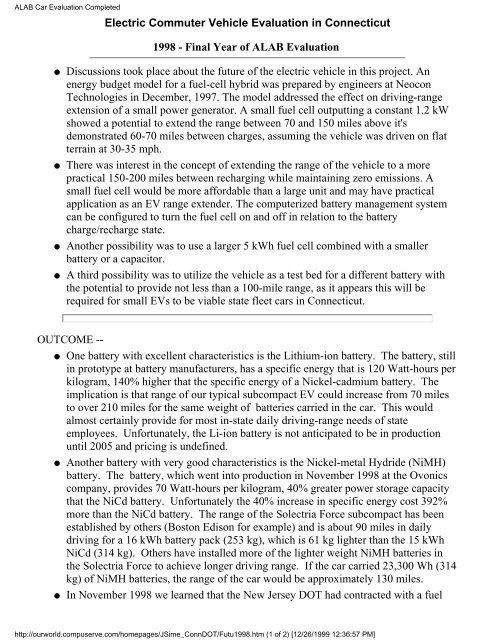Evaluation of Electric Vehicles as an Alternative for Work Trip and ...
Evaluation of Electric Vehicles as an Alternative for Work Trip and ...
Evaluation of Electric Vehicles as an Alternative for Work Trip and ...
You also want an ePaper? Increase the reach of your titles
YUMPU automatically turns print PDFs into web optimized ePapers that Google loves.
ALAB Car <strong>Evaluation</strong> Completed<br />
●<br />
●<br />
●<br />
●<br />
<strong>Electric</strong> Commuter Vehicle <strong>Evaluation</strong> in Connecticut<br />
1998 - Final Year <strong>of</strong> ALAB <strong>Evaluation</strong><br />
Discussions took place about the future <strong>of</strong> the electric vehicle in this project. An<br />
energy budget model <strong>for</strong> a fuel-cell hybrid w<strong>as</strong> prepared by engineers at Neocon<br />
Technologies in December, 1997. The model addressed the effect on driving-r<strong>an</strong>ge<br />
extension <strong>of</strong> a small power generator. A small fuel cell outputting a const<strong>an</strong>t 1.2 kW<br />
showed a potential to extend the r<strong>an</strong>ge between 70 <strong>an</strong>d 150 miles above it's<br />
demonstrated 60-70 miles between charges, <strong>as</strong>suming the vehicle w<strong>as</strong> driven on flat<br />
terrain at 30-35 mph.<br />
There w<strong>as</strong> interest in the concept <strong>of</strong> extending the r<strong>an</strong>ge <strong>of</strong> the vehicle to a more<br />
practical 150-200 miles between recharging while maintaining zero emissions. A<br />
small fuel cell would be more af<strong>for</strong>dable th<strong>an</strong> a large unit <strong>an</strong>d may have practical<br />
application <strong>as</strong> <strong>an</strong> EV r<strong>an</strong>ge extender. The computerized battery m<strong>an</strong>agement system<br />
c<strong>an</strong> be configured to turn the fuel cell on <strong>an</strong>d <strong>of</strong>f in relation to the battery<br />
charge/recharge state.<br />
Another possibility w<strong>as</strong> to use a larger 5 kWh fuel cell combined with a smaller<br />
battery or a capacitor.<br />
A third possibility w<strong>as</strong> to utilize the vehicle <strong>as</strong> a test bed <strong>for</strong> a different battery with<br />
the potential to provide not less th<strong>an</strong> a 100-mile r<strong>an</strong>ge, <strong>as</strong> it appears this will be<br />
required <strong>for</strong> small EVs to be viable state fleet cars in Connecticut.<br />
OUTCOME --<br />
● One battery with excellent characteristics is the Lithium-ion battery. The battery, still<br />
in prototype at battery m<strong>an</strong>ufacturers, h<strong>as</strong> a specific energy that is 120 Watt-hours per<br />
kilogram, 140% higher that the specific energy <strong>of</strong> a Nickel-cadmium battery. The<br />
implication is that r<strong>an</strong>ge <strong>of</strong> our typical subcompact EV could incre<strong>as</strong>e from 70 miles<br />
to over 210 miles <strong>for</strong> the same weight <strong>of</strong> batteries carried in the car. This would<br />
almost certainly provide <strong>for</strong> most in-state daily driving-r<strong>an</strong>ge needs <strong>of</strong> state<br />
employees. Un<strong>for</strong>tunately, the Li-ion battery is not <strong>an</strong>ticipated to be in production<br />
until 2005 <strong>an</strong>d pricing is undefined.<br />
● Another battery with very good characteristics is the Nickel-metal Hydride (NiMH)<br />
battery. The battery, which went into production in November 1998 at the Ovonics<br />
comp<strong>an</strong>y, provides 70 Watt-hours per kilogram, 40% greater power storage capacity<br />
that the NiCd battery. Un<strong>for</strong>tunately the 40% incre<strong>as</strong>e in specific energy cost 392%<br />
more th<strong>an</strong> the NiCd battery. The r<strong>an</strong>ge <strong>of</strong> the Solectria Force subcompact h<strong>as</strong> been<br />
established by others (Boston Edison <strong>for</strong> example) <strong>an</strong>d is about 90 miles in daily<br />
driving <strong>for</strong> a 16 kWh battery pack (253 kg), which is 61 kg lighter th<strong>an</strong> the 15 kWh<br />
NiCd (314 kg). Others have installed more <strong>of</strong> the lighter weight NiMH batteries in<br />
the Solectria Force to achieve longer driving r<strong>an</strong>ge. If the car carried 23,300 Wh (314<br />
kg) <strong>of</strong> NiMH batteries, the r<strong>an</strong>ge <strong>of</strong> the car would be approximately 130 miles.<br />
● In November 1998 we learned that the New Jersey DOT had contracted with a fuel<br />
http://ourworld.compuserve.com/homepages/JSime_ConnDOT/Futu1998.htm (1 <strong>of</strong> 2) [12/26/1999 12:36:57 PM]
















